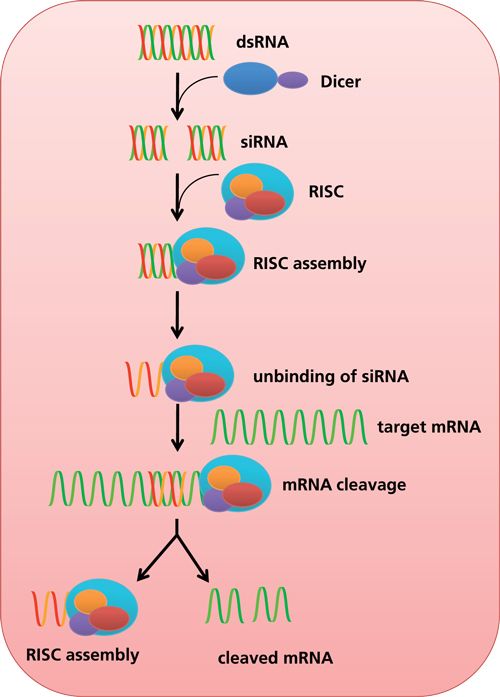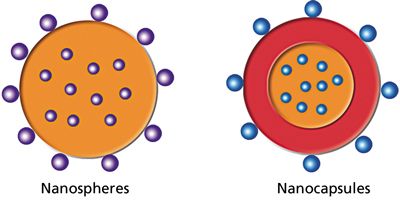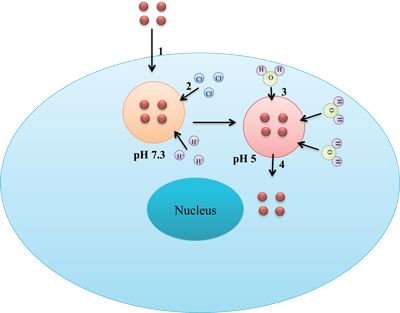Perspectives and Challenges of Nanomedicine in Gene Silencing
Advances in nanomedicine have provided several potential candidates for safe and effective delivery of siRNA.
MAcieJ FroloW/getty iMAges

There is a wide interest in gene delivery in today’s post-genomic era, in which new drug targets are continually being identified for the treatment of various diseases, such as cancer. Furthermore, the rapid progress in biotechnology has contributed to the development of a large number of bioactive molecules and vaccines based on peptides, proteins, and oligonucleotides.
The expression of malfunctioning genes can be masked by using small-interfering ribonucleic acids (siRNAs) through a highly conserved natural process that controls the selective post-transcriptional down-regulation of target genes in the cells. RNA sequences of up to 21-23 bases long of double-stranded nucleotides have been used for RNA interference (see Figure 1).
Figure 1: Mechanism of RNA interference. Double-sranded RNA (dsRNA) molecules are cleaved by Dicer yielding siRNA. siRNAs gets incorporated into the RNA-induced silencing complex (RISC) assembly, followed by unwinding of the double-stranded molecule by the helicase activity of RISC. The sense strand of siRNA is removed and the antisense strand binds to the targeted mRNA, which is then cleaved by RISC and subsequently degraded by cellular nucleases. All figures courtesy of the authors.

The clinical applications of RNA interference (RNAi) are, however, limited due to their poor cellular uptake and rapid degradation by nucleases. As a result, there is a need for a vehicle that can deliver siRNA effectively, safely, and repeatedly to both the
in-vitro and in-vivo milieu. Advances in nanomedicines have provided several potential candidates for the effective and targeted delivery of siRNA.
Nanomedicine is an umbrella term used for nanoparticles, polymeric micelles, quantum dots, liposomes, and other sub-microscopic material with potential clinical utility that are in the nanometer size range. Nanoparticles have evolved as one of the most promising candidates for gene delivery. Their extremely small size (i.e., at least one dimension less than 100 nm) enable the nanoparticles to achieve better tissue penetration and targeting. Nanoparticles fabricated from polymers have been largely explored to deliver DNA and siRNA. These nanoparticles are classified as nanospheres (i.e., nanometer-size particles capable of either entrapping the desired molecules inside the sphere or adsorbing them on the outer surface or both) and nanocapsules (i.e., nanometer-size particles with a solid polymeric shell and an inner liquid core capable of entrapping the desired molecules or adsorbing on the outer surface or both) (see Figure 2). Several natural and synthetic polymers, such as polyethylenimine (PEI), protamine, poly-L-lysine, atelocollagen, and chitosan, have been explored for engineering nanoparticles to deliver siRNA.
Figure 2: Types of nanoparticles.

Challenges and advances in nanoparticle-mediated siRNA delivery
Efficient internalization of siRNA by cells is hindered by the presence of negative charges on the siRNA as well as rapid enzymatic disintegration by nucleases. To solve this issue, siRNAs have been complexed with cationic polymers, resulting in condensation of siRNA due to the electrostatic interaction between the nitrogen groups of the polymer and the phosphate groups of siRNA (N/P ratio). This complexation not only reduces the siRNA to form nanoparticles, but also imparts the positive charge needed for interaction with cells and protects the siRNA from enzymatic degradation by making it inaccessible to nucleases. The size of the nanoparticles generated by complexation depends on several factors such as the concentration of siRNA, pH, the type of buffer used, and the N/P ratio. The characteristics of the nanoparticles can also be modified by attaching various targeting moieties such as RGD (Arg-Gly-Asp) peptides or transferrin to achieve more targeted or specific delivery of siRNA (1, 2).
The stability of chitosan-siRNA nanoparticles have been previously investigated in the presence of serum by incubating free and chitosan-complexed siRNA in 5% fetal bovine serum (FBS) at 37 °C (3). The siRNA remained intact for up to 30 min and was fully degraded after 48 h. On the contrary, siRNA recovered from chitosan-tripolyphosphate (TPP) nanoparticles started to degrade only after 24 h of incubation and was almost completely degraded after 72 h of incubation. Incubation of siRNA and chitosan-siRNA nanoparticles in 50% serum concentration showed that the chitosan-siRNA nanoparticles protected siRNA from nuclease activity. Studies conducted using two different cell lines, chinese hamster ovary cells (CHO K1) and human embryonic kidney cells (HEK 293), revealed that the method of siRNA complexation with chitosan plays an important role on gene silencing (3). Nanoparticles prepared by cross-linking chitosan with TPP and encapsulating the siRNA were found to be better vectors compared with chitosan-siRNA complexes. The reason for this was thought to be due to the high binding capacity and loading efficiency of chitosan-TPP nanoparticles (3).
Following internalization, the intracellular vesicles carrying the siRNA-polymer nanoparticles would fuse with the degrading endocytic vesicles, which is another major barrier to efficient siRNA delivery. Several hypotheses have been proposed for the endosomal escape of nanoparticles, including physical disruption of the negatively charged endosomal membrane by direct interaction with the cationic polymer, or the so-called proton-sponge mechanism. PEI, often considered as the gold standard of gene transfection, mediates escape of nanoparticles through the proton-sponge mechanism (see Figure 3). PEI (2 to 800 kDa molecular weight [MW]) is one of the most widely explored gene-delivery vectors (4, 5) because of its high membrane destabilization potential and charge density (i.e., nucleic acid condensation capability). PEI occurs as branched or linear morphological isomers, depending on the linkage of the repeating ethylenimine unit. In one study, nanoparticles employing branched PEI (MW 750 kDa) were prepared with alginic acid to combine the properties of a cationic PEI with the polysaccharide alginate (6). The PEI-alginate (6.26% amino groups derivatized by alginate) nanoparticles efficiently delivered siRNAs into mammalian cells, resulting in 80% suppression of green fluorescent protein (GFP) expression. In another report, nanoparticles were prepared by acylating PEI with propionic anhydride followed by cross-linking with polyethylene glycol-bis(phosphate) (7). In vitro siRNA delivery studies in HEK 293 cells using these nanoparticles showed up to 85% inhibition of GFP gene expression, which was comparable to that of siRNA-Lipofectin (81% inhibition).
Figure 3: Schematic representation of the “proton sponge effect.” The initial step is endocytosis of the PEI nanoparticles (1), followed by acidic endosome buffering (2),intake of water (3) leading to an increase in osmotic pressure, lysis, and consequently, the release of the nanoparticles (4).

Thermosensitive cationic polymeric nanocapsules based on temperature induced swelling (~119 nm at 37 °C and ~412 at 15 °C), which results in physical disruption of the endosome have also been evaluated for the delivery of siRNA (8). As an alternative strategy, short peptides, known as cell-penetrating peptides (CPPs) that are capable of translocating through biological membranes, have been used to modify polyplexes to improve endosomal release of siRNAs (9). Decomplexation resulting in the release of siRNA from the nanoparticles complex is required for efficient gene silencing and stability is desirable for protection of the siRNA. A subtle balance between protection and release of siRNA is, therefore, required for efficient silencing with nanoparticles (10, 11). Bioresponsive nanoparticles where release of siRNA occurs in response to intracellular stimulus have been used to facilitate this process.
Upon in-vivo administration, rapid clearance by the reticuloendothelial system (RES), or more specifically, the Kupffer cells in the liver and splenic macrophages, is another major problem hindering efficient siRNA delivery. To circumvent this issue, the nanoparticles are either coated with biocompatible polymers such as polyethylene glycol (PEG), or the polymers used to prepare nanoparticles are chemically modified by grafting or cross-linking with PEG. Conjugation of PEG to PEI nanoparticles has been shown to significantly improve the movement of siRNA into the lungs, liver and tumors (1).
Despite the advantages and successful employment in numerous studies, nanoparticles also have their drawbacks. For instance, the cationic polymers constituting the nanoparticles undergo strong electrostatic interaction with plasma membrane proteins, which can lead to destabilization and ultimately, rupture of the cell membrane (12). Several strategies have been proposed to mask this issue, which includes reducing the surface charge of the nanoparticles by coating them with anionic or neutral molecules such as hyaluronic acid (HA) or PEG (13, 14).
Future perspectives
To summarize, the therapeutic applications of siRNA-mediated gene knockdown is dictated by various factors including protection of siRNA, effective transfection levels, biocompatibility and reduced side effects, high efficacy at low doses of siRNAs, manipulations to fit different treatment regimens, and vectors that can overcome intracellular and extracellular barriers to reach the target tissue/organ. While the successful delivery of siRNA in various experimental models have been reported, there still remains several issues that need to be resolved before siRNAs can be used as a therapeutic tool (15).
References
1. R.M. Schiffelers et al., Nucleic Acids Res 32 (19) e149 (2004).
2. M.E. Davis, Mol Pharm 6 (3) 659-668 (2009).
3. H. Katas, and H.O. Alpar, J Control Release 115 (2) 216-225 (2006).
4. W.T. Godbey, K.K. Wu, and A.G. Mikos, J Control Release 60 (2-3) 149-160 (1999).
5. G. Creusat et al., Bioconjug Chem 21 (5) 994-1002 (2010).
6. S. Patnaik et al., J Control Release 114 (3) 398-409 (2006).
7. S. Nimesh and R. Chandra, Eur J Pharm Biopharm 73 (1) 43-49 (2009).
8. S.H. Lee et al., J Control Release 125 (1) 25-32 (2008).
9. T. Endoh and T. Ohtsuki Adv Drug Deliv Rev 61 (9) 704-709 (2009).
10. K. Zhang et al., Biomaterials 30 (5) 968-977 (2009).
11. K. Zhang, et al., Biomaterials 31 (7) 1805-1813 (2010).
12. D. Fischer et al., Biomaterials 24 (7) 1121-1131 (2003).
13. G. Jiang et al., Biopolymers 89 (7) 635-642 (2008).
14. Y. Duan et al., Hum Gene Ther 21 (2) 191-198 (2010).
15. T.S. Zimmermann et al., Nature 441, 111-114 (2006).

Drug Solutions Podcast: Applying Appropriate Analytics to Drug Development
March 26th 2024In this episode of the Drug Solutions Podcast, Jan Bekker, Vice President of Business Development, Commercial and Technical Operations at BioCina, discusses the latest analytical tools and their applications in the drug development market.